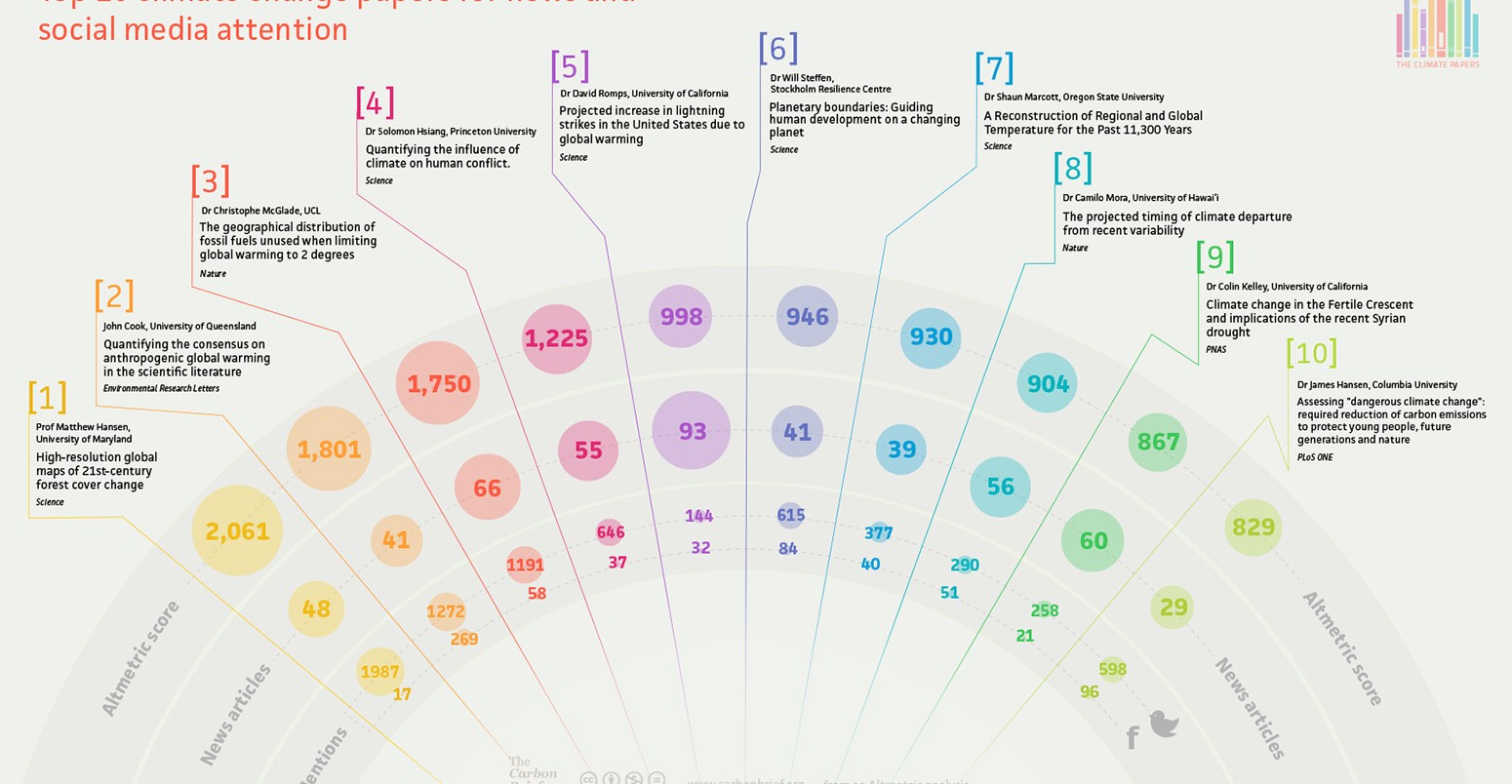
Updated: The climate change papers most featured in the media
Robert McSweeney
07.29.15Robert McSweeney
29.07.2015 | 3:45pmIn our recent series on the top climate change papers, we brought you which ones scientists think are the most influential and which are the most cited by other researchers.
With the help of Altmetric, we also looked into which research articles have made the biggest splash in the news and on social media. But, as a few eagle-eyed readers pointed out to us, it seems there were some papers that were overlooked.
Altmetric has now expanded their search to make sure no paper is missed. So here’s our revised take on which papers have made the biggest impact in the wider world.
Media mentions
Altmetric tracks when academic papers are mentioned in online news articles and on social media platforms, such Twitter and Facebook. It collates these mentions and gives each paper a score for how much attention it received. Featuring in a major national newspaper will contribute a bigger score to a paper than being in a niche publication. A paper with no mentions will score zero, for example, while an article with a score of over 20 has received significant attention from journalists or perhaps caused a stir online.
To match our analysis of the most cited climate change papers, Altmetric ran a keyword search for papers mentioning “climate change” or “global warming”. However, the original Altmetric search capped the number of papers it returned to 10,000, which meant some high-scoring papers were missed off.
Altmetric’s founder, Euan Adie, explains to Carbon Brief:
What I didn’t realize when pulling this data the first time round was that the search engine I used to find articles with the two terms we were interested in only returned the ‘most relevant’ results. Instead of 17,000 results we got back 10,000, and amongst the missing articles were many that, to be consistent, should have been in the top 100. This means the original data was incomplete and the ranking was out; the updated data fixes this.
Altmetric have now extended this cap to 20,000 papers, and intend to remove the cap completely in the near future. You can try out the tool yourself with the Altmetric Explorer.
From the new set of search results, we filtered out all the entries that were news, editorials and books, leaving just research articles to analyse, which we then trimmed to a top 100.
Unfortunately, this did mean cutting out the highest-scoring climate change article of any kind, which was a spoof News & Views piece in Nature on the reemergence of dragons due to warmer temperatures, published on 1st April this year.
Finally, one point to note is that Altmetric only started tracking papers in July 2011, so this analysis only covers papers published over the past four years.
So what research have we all been reading and tweeting about?
Top paper
The top-ranked article is “High-Resolution Global Maps of 21st-Century Forest Cover Change” by lead author Prof Matthew Hansen at the University of Maryland in the US, which was published in November 2013.
The paper describes how the researchers used satellite data to map global forest change between 2000 and 2012. They found that forest losses of around 2.3m square kilometers (sq km) outweighed gains of 0.8m sq km. With the help of Google Earth, the team created an interactive mapping tool to show changes in forests down to a resolution of just 30 metres.
Hansen and his colleagues found forest clearance was largest in the tropics, with increases in deforestation in Indonesia, Malaysia, Paraguay, Bolivia, Zambia and Angola offsetting a reduction in Brazil.
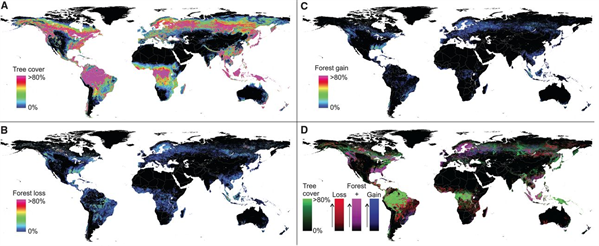
Maps showing a) tree cover, b) forest loss, and c) forest gain between 2000 and 2012. Map d) shows a composite of tree cover in green, forest loss in red, forest gain in blue, and areas of forest loss and gain in magenta. Source: Hansen et al. (2015)
The paper has featured in 48 news stories and has done particularly well on Mendeley, an academic social network where you can save and share research articles. It has also been tweeted almost 2,000 times (not including retweets and favourites) – receiving more attention on Twitter than any other paper in Altmetric’s search.
Overall, Altmetric gives the paper a score of 2,061. This puts it at number 56 of all four million articles that Altmetric has tracked across all topics.
For reference, the top score of any article on Altmetric is over 11,000. This goes to a light-hearted paper in the Canadian Medical Association Journal that undertakes a psychoanalysis of Winnie the Pooh and his friends of Hundred Acre Wood.
Runner-up
The paper ranked second is “Quantifying the consensus on anthropogenic global warming in the scientific literature” in the journal Environmental Research Letters, by lead author John Cook of the University of Queensland in Australia. (This had appeared at number one when Altmetric first did its search for the original version of this article.)
The paper analysed around 12,000 journal articles about climate change and found 97% agreed that humans were the principal cause. This figure – and the paper – received a lot of attention from the press, featuring in no less than 18 articles in The Guardian, 12 in Huffington Post, and even on comedian John Oliver’s Last Week Tonight. Though it’s worth mentioning that one of the paper’s authors, Dana Nuccitelli, also writes for The Guardian website, and penned around half of their 18 articles.
Quantifying something as complicated as consensus is not straightforward, and not everyone agreed with the approach the paper took. This perhaps makes the paper all the more newsworthy as it prompted a lot of debate around what consensus means and how it can be measured.
The paper has been mentioned widely on social media as well. It was tweeted 1,272 times – including a tweet from no less than US President Barack Obama – and was posted on 269 Facebook walls.
Unburnable coal
Coming in third, with a score of 1,733, is the Nature article, ” The geographical distribution of fossil fuels unused when limiting global warming to two degrees” by Dr Christophe McGlade and Prof Paul Ekins at University College London.
The big news story from this paper was that to keep global temperature rise to no more than 2C, 80% of known coal reserves need to remain unburned, while the same goes for 50% and 30% of known gas and oil reserves respectively. The paper featured in four articles in The Guardian, 10 in The Huffington Post, and once in the Daily Mail.
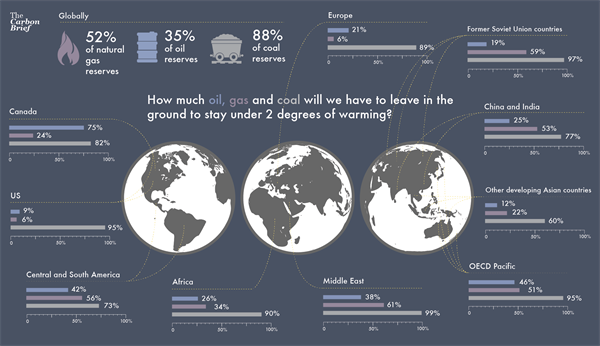
How much oil, gas and coal will we have to leave in the ground to stay under 2 degrees of warming. Credit: Rosamund Pearce, Carbon Brief derived from McGlade et al. (2014)
Lightning, civil war and protecting future generations
A brief look at the rest of the top 10 shows an intriguing mix.
Fifth place goes to a Science paper on the projected increase in lightning strikes in the US, led by Dr David Romps at University of California, Berkeley. The research finds that climate change could mean a 50% increase in lightning hitting mainland America by the end of the century.
This paper received more attention by the online news media than any other in our analysis.
Ninth is “Climate change in the Fertile Crescent and implications of the recent Syrian drought“, by lead author Dr Colin Kelley from the University of California, Santa Barbara. This paper was published in the Proceedings of the National Academy of Sciences of the United States of America – more snappily known as ‘PNAS’. It suggests a severe drought that began in 2006 was a catalyst for the Syrian conflict, and that climate change has made such droughts in the region more than twice as likely.
The link between climate change and conflict is widely debated, which is perhaps why it received so much media attention.
Completing the top 10 is Dr James Hansen’s paper on assessing dangerous climate change, published in PLoS ONE in 2013. This paper defines the greenhouse gas emission reductions needed to avoid potentially disastrous climate impacts on young people of today and tomorrow.
You can see the complete top 10 in the infographic below, and you can also take a look at this spreadsheet for all the top 100.
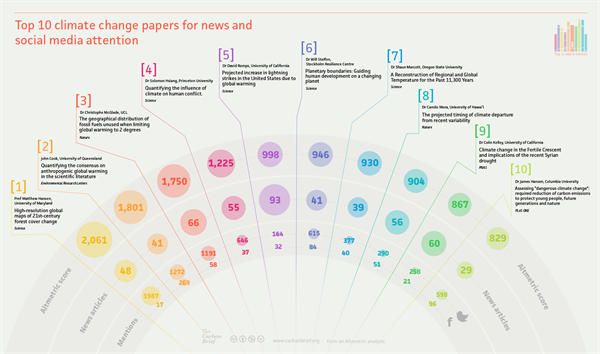
Infographic of top 10 papers for news and social media attention. Data from Altmetric. Credit: Rosamund Pearce, Carbon Brief
Grabbing the headlines
In our analysis of the most cited climate change papers, we found that Nature and Science account for more than half of the top 100. But are they as dominant when it comes to media attention? The short answer is no.
It’s actually one of Nature’s sister journals – Nature Climate Change – that tops the list, with over a third of Altmetric’s top 100.
PNAS comes in second with 20 papers, while Science and Nature come in third and fourth, with 15 and eight papers respectively – though Science does have five of the top 10.
You can see which journals make up the rest of the top 100 in the chart below.
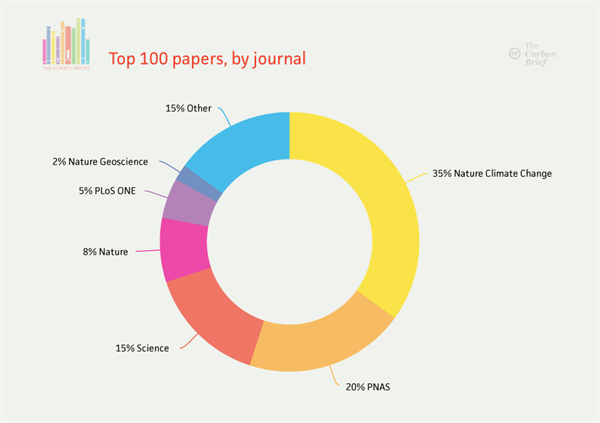
Top 100 papers of news and social media attention, by academic journal. Data from Altmetric. Credit: Rosamund Pearce, Carbon Brief

